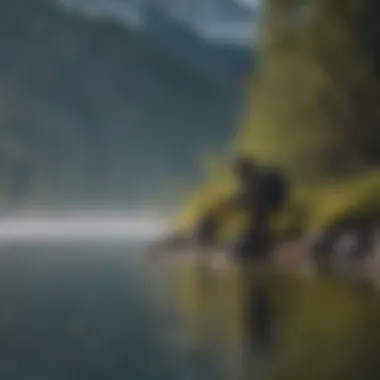Fishing in the Yukon: An In-Depth Exploration


Intro
Fishing in the Yukon offers an unparalleled experience, attracting both seasoned anglers and novices alike. The vast, breathtaking landscapes, paired with the abundance of fish species, create an environment that is not just recreational but also essential to the local ecology. Here, we delve into the details surrounding fishing, from the species that populate its rivers and lakes to the regulations that safeguard these natural resources.
The Yukon is home to a diverse array of fish species. This includes the mighty salmon, which is crucial to the ecosystem, and other species such as trout and char, each contributing to the intricate balance of life in the region. Understanding the habitats and behaviors of these fish is vital for anyone looking to engage in fishing here.
This region is governed by specific regulatory frameworks to protect its rich biodiversity and cultural heritage. The Yukon's fishing regulations aim to promote sustainable practices, ensuring that fish populations remain viable for future generations. Knowledge of these regulations is essential for both recreational and commercial fishermen.
Through a comprehensive examination, this article aims to shed light on various aspects of fishing in the Yukon. We will explore key species profiles, conservation efforts, and the cultural impacts of fishing. By doing so, we hope to provide readers with an insightful understanding of fishing in this unique wilderness.
Prologue to Yukon Fishing
Fishing in the Yukon presents a complex interplay between tradition, environment, and economy. It is not merely a recreational activity; it embodies a deep connection to the land and its resources. This section provides context and lays the groundwork for understanding different aspects of Yukon's fishing landscape. It discusses the significance of fishing as a vital aspect of life for many Yukoners, highlighting cultural traditions and ecological dependencies.
Overview of the Yukon Territory
The Yukon Territory, located in the northwestern part of Canada, is renowned for its rich natural resources and stunning landscapes. Stretching over 480,000 square kilometers, it encompasses vast forests, rivers, and numerous lakes, creating an ideal habitat for various aquatic species. The Yukon River, one of the longest rivers in North America, flows through the territory, serving as a critical waterway for both Indigenous cultures and settlers alike.
The unique geography of the Yukon contributes to its ecological diversity. Cold-water species thrive here, along with a mix of migratory fish that play a significant role in local ecosystems. Understanding the geographic and ecological profiles of this region is essential for appreciating the broader context of fishing practices within it.
Historical Context of Fishing Practices
Fishing practices in the Yukon are deeply rooted in the region's history. For Indigenous communities, fishing has always been more than a means of sustenance; it carries cultural significance and spiritual elements. Traditionally, methods varied according to the season and the species sought. Techniques such as netting, spear fishing, and fish traps were often employed, showcasing a profound understanding of local aquatic ecosystems.
Moreover, the exploitation of fish resources increased significantly during the Gold Rush era in the late 19th century when an influx of miners and settlers escalated commercial fishing. This period marks a transformative point in the fishing landscape of the Yukon, as it introduced new practices and challenges. The tensions between conservation and economic development continue to influence fishing regulations and practices today.
"Fishing represents a vital link to the past, serving as an anchor for traditions and livelihood in the Yukon."
As we delve deeper into the ecological, economic, and cultural dimensions of fishing in the Yukon, these historical contexts will illuminate the complexities and current challenges faced by both fish populations and local communities.
Ecological Significance of Yukon Waters
Yukon waters represent a complex intertwining of ecosystems, providing essential habitats that support a rich variety of life. Understanding this significance is critical, not only for the health of the aquatic species but also for the sustainability of fishing practices in the region. The waterways have existed in a delicate balance, benefiting from pristine conditions that promote biodiversity. This section emphasizes both the ecological roles played by these waters and the broader benefits they offer to local communities and ecosystems alike.
Freshwater Ecosystems
The freshwater ecosystems in Yukon sustain a myriad of life forms. Lakes, rivers, and wetlands create dynamic environments that fluctuate with the seasons. These ecosystems help filter water, support nutrient cycling, and offer breeding grounds for various species. The health of these ecosystems directly influences the quality of fishing. Key components of these ecosystems include:
- Nutrient Availability: Rich nutrient loads support algae growth, which is foundational for fish populations.
- Habitat Complexity: Pools, riffles, and submerged structures provide ideal spawning habitats for fish.
- Connectivity: The interconnected nature of waterways facilitates fish migration and genetic diversity.
The maintenance of these freshwater ecosystems ensures not only the survival of fish species but also the preservation of other wildlife that rely on these habitats. Conservation efforts play a vital role in preserving these delicate ecosystems against the pressures of climate change and human activity.
Biodiversity in Yukon Rivers and Lakes
Biodiversity in Yukon’s waterways is impressive and serves multiple functions. Healthy ecosystems are characterized by a wide variety of species, which help sustain balanced populations and prevent any one species from overwhelming the system. The diversity of species in Yukon’s lakes and rivers includes:
- Salmon Species: Chinook, coho, and sockeye salmon are critical for the cultural and ecological fabric of the region.
- Trout Variants: Species like lake trout and bull trout inhabit various aquatic zones, showcasing adaptability to different conditions.
- Other Notable Species: Various whitefish, grayling, and northern pike contribute to the ecological balance.
The existence of this biodiversity enhances resilience against environmental changes. A decline in one species can impact others and disrupt the entire food web.
"Preserving biodiversity is more crucial today than ever; the well-being of ecosystems is directly tied to the ecological health of river and lake systems."


Target Fish Species
Fishing in the Yukon encompasses a variety of species, each with its own ecological and economic importance. Understanding target fish species is crucial for both enthusiasts and conservationists. The diverse aquatic life provides opportunities for sport fishing, contributes to local cultures, and supports the regional economy through tourism.
Salmon Varieties
Salmon is among the most recognized fish species in the Yukon, primarily because of its migratory nature and the cultural significance it holds. There are several varieties of salmon in the region, which include Chinook, Coho, Sockeye, and Pink salmon. Each variety exhibits unique behaviors and adaptations, contributing to the remarkable biodiversity of Yukon waters.
Salmon spawn in freshwater rivers and lakes, making their lifecycle vital for many ecosystems. Their return to natal streams after years spent at sea ensures nutrient transfer back to terrestrial systems, enriching the ecosystem. Fishermen often target these fish due to their popularity, culinary value, and iconic status in Yukon culture.
- Chinook Salmon: The largest species, known for its rich flavor and high oil content.
- Coho Salmon: Valued for its bright color and firm texture, it provides an exciting fishing challenge.
- Sockeye Salmon: Recognized for its striking red color; popular in both sport and commercial fishing.
- Pink Salmon: Smaller in size, but abundant and easy to catch during their spawning runs.
Trout Species Found in the Yukon
The Yukon also hosts various trout species, which play a significant role in the fishing landscape. Both Rainbow Trout and Lake Trout inhabit the region's chilly waters, presenting unique challenges and rewards for anglers.
- Rainbow Trout: Known for their striking appearance and fight, these fish thrive in clear, cold streams and lakes. They are often sought after by sport fishermen for their beauty and resistance during catch.
- Lake Trout: Adapted to deeper waters, Lake Trout are a prime target during the longer summer days. They can grow to significant sizes, making them a noteworthy catch.
Trout fishing in the Yukon aligns well with the recreational fishing season, offering enthusiasts an array of environments to explore. The variability in water conditions contributes to the distinct characteristics of each species, appealing to various fishing preferences.
Other Notable Fish Species
Beyond salmon and trout, the Yukon waters are home to other significant fish species. For example, Northern Pike and Arctic Grayling hold substantial appeal for those seeking variety in fishing.
- Northern Pike: A top predator in Yukon waters, known for its aggressive nature and remarkable size. Fishermen often find this species exciting due to its strong fight once hooked.
- Arctic Grayling: Celebrated for their beauty and camaraderie, they inhabit the cold, flowing streams of the region. They are an excellent catch for beginner anglers and offer a taste of isolation in less frequented spots.
Other species like Burbot, whitefish, and char also contribute to the ecological balance and offer additional fishing opportunities. These fish diversify the fishing experience in the Yukon.
The following factors underline the importance of targeting these species:
- Ecological balance: Each species has its own role within the ecosystem.
- Cultural relevance: Salmon and trout are central to the local heritage and traditions.
- Economic impact: Recreational fishing generates revenue through tourism and local businesses.
Understanding target fish species helps fishermen and conservationists work collaboratively for sustainable practices that benefit both the community and the ecology of the Yukon.
Methods of Fishing in the Yukon
Fishing in the Yukon is more than simply baiting a hook. The diverse methods employed by anglers reveal a profound relationship between the fish, the ecosystem, and human culture. Understanding these methods is essential for anyone looking to appreciate the full scope of fishing in this unique region. Different approaches to fishing reflect the varying conditions of Yukon waters and aim to conserve its rich ecological heritage while ensuring sustainable practices. This section delves into the different methods employed in the Yukon and their significance in both practical and cultural contexts.
Traditional Techniques
Traditional fishing techniques have deep roots in the Yukon. Indigenous peoples have practiced these methods for centuries, using skills and knowledge passed down through generations.
Some key traditional methods include:
- Net fishing: One of the oldest techniques where nets are set in rivulets during spawning seasons to catch salmon. This method allows communities to gather fish without depleting stocks.
- Fish traps: Ingeniously constructed traps, often made from local materials, capture fish as they swim upstream. These mechanisms demonstrate a deep understanding of fish behavior.
- Spearfishing: This method involves using a spearing technique to catch fish from the water. It requires precision and is often accompanied by significant cultural practices.
The importance of these traditional methods lies not only in their effectiveness but also in their connection to cultural identity and sustainability. These practices promote a symbiotic relationship with nature, fostering respect for the local ecosystem.
Modern Approaches to Fishing
In contrast to traditional methods, modern approaches to fishing in the Yukon leverage technology and contemporary techniques. These methods focus on efficiency and adaptability to various conditions. Some notable ones are:


- Fly fishing: Popular among recreational anglers, fly fishing has gained traction in the Yukon due to its effectiveness in rivers and lakes. It requires specialized equipment and techniques that allow for a refined angling experience.
- Ice fishing: During winter, many locals and tourists engage in ice fishing. Holes are drilled into the ice, providing access to fish beneath the frozen surfaces. This method requires different tactics, including the use of specialized gear and bait.
- Catch and release: This modern practice encourages sustainable fishing. It aims to minimize the impact on fish populations by promoting the careful handling and return of fish to their habitats.
These modern methods, while efficient, raise discussions about the balance between technology and conservation. The challenge is to benefit from advancements while remaining mindful of the delicate ecosystems that support the diverse fish populations in the Yukon.
"The beauty of fishing in the Yukon lies in its blend of old and new, respecting historical techniques while embracing modern advancements."
Understanding both traditional and modern techniques enhances appreciation for the cultural richness of fishing in the Yukon and encourages responsible practices that harmonize with the environment.
Regulations and Conservation Efforts
The Ykon’s fishing regulations and conservation efforts are paramount, aimed at sustaining the rich aquatic life while balancing ecological integrity and human activity. As fishing continues to be a critical component of local economies and indigenous cultures, these regulations serve not just as legal frameworks, but also as essential guidelines for preserving the biodiversity found in Yukon waters.
Fishing Licenses and Permits
To engage in fishing within the Yukon, individuals must obtain the appropriate licenses and permits. These regulatory measures are crucial for managing fish populations and ensuring sustainable practices. The licenses vary depending on the type of fishing: recreational, commercial, or subsistence. Additionally, certain areas may have specific restrictions related to seasons, quotas or size limits that must be adhered to.
- Why are licenses important? They facilitate a regulated approach to fishing ensuring that there is accountability among anglers. This selective fishing helps protect vulnerable species and allows fisheries managers to monitor populations accurately.
- Who needs permits? Both residents and tourists are required to hold valid permits. Special considerations apply for certain species, especially those that are threatened or endangered.
- Where to acquire them? Permits can typically be obtained through local governmental departments, including the Yukon Department of Environment or online platforms.
Conservation Initiatives in the Yukon
The Yukon boasts a number of conservation initiatives designed to protect its natural waterways and the organisms within them. These efforts engage a range of stakeholders including governmental bodies, indigenous groups, and local communities, working collectively towards sustainable fisheries management.
Some notable initiatives include:
- Habitat Restoration Projects: These projects focus on restoring and rehabilitating fish habitats in harmed ecosystems. Creating proper riparian buffers or restoring spawning grounds ensures that fish populations can thrive.
- Community Engagement Programs: Local communities play a pivotal role in conservation through education and participation in citizen science projects. Engaging the community fosters a sense of stewardship over the environment.
- Monitoring Programs: Regular assessments of fish populations and water quality are essential. Monitoring allows authorities to make informed decisions regarding fishing quotas and other regulations based on real-time data.
By understanding regulations and actively participating in relevant initiatives, individuals can contribute to the conservation of the Yukon’s delicate aquatic ecosystems. This responsibility is not just a legal obligation but a moral imperative for those who wish to enjoy the natural beauty and resources of the region.
Cultural and Economic Impacts of Fishing
Fishing in the Yukon not only serves as a source of sustenance but also as a vital component of cultural identity and economic stability. The significance of fishing practices extends far beyond the act itself. For many residents, particularly Indigenous communities, fishing embodies a connection to ancestral traditions, spirituality, and the land. The economy also benefits significantly from the fishing industry, which sustains livelihoods and fosters community development. Here, we delve deeper into these facets, highlighting their interdependence and relevance.
Fishing in Indigenous Cultures
Fishing holds a sacred place in the lives of Indigenous peoples in the Yukon. It is a practice interwoven with cultural heritage, beliefs, and ceremonies. For these communities, fishing is not merely a source of food; it represents a way of life that emphasizes respect for nature.
Methods such as net fishing, spear fishing, and ice fishing have been passed down through generations. Each method reflects unique cultural practices and ties to the environment. Fishing activities often accompany seasonal gatherings, encouraging storytelling, sharing knowledge, and preserving community bonds.
Furthermore, traditional fishing plays a role in teaching younger generations about sustainability and the importance of ecological stewardship. This intrinsic connection helps ensure that Indigenous perspectives and values are integrated into modern conservation efforts. As a result, understanding fishing's cultural significance becomes critical in recognizing the broader implications of ecological preservation.
Fishing as an Economic Activity
The economic aspects of fishing in the Yukon are equally compelling. The industry not only supports commercial fishing but also promotes tourism. Fish species, such as salmon and trout, attract recreational fishers, thereby boosting local economies. Businesses related to fishing, including guides, bait shops, and lodgings, thrive on this influx of tourists.
Some key economic contributions of the fishing sector include:
- Job Creation: Fishing provides direct and indirect employment opportunities in both urban and rural areas.
- Revenue Generation: Commercial fishing and related services contribute significantly to local and regional economies.
- Supporting Local Communities: The revenues from fishing often fund community projects, social programs, and educational initiatives.
However, fishing in the Yukon is not without challenges. Sustainability and responsible practices are paramount to ensure that fishing remains economically viable and protects the ecological balance. Addressing issues like overfishing and environmental changes is critical for future generations.
"Fishing in the Yukon is a tapestry woven from cultural threads and economic necessities. Preserving this balance is vital for the continuation of both traditions and livelihoods."


This interconnectedness of culture and economy underscores the importance of fishing as more than just an activity; it is a significant part of Yukon’s identity that requires thoughtful stewardship.
Challenges Facing Yukon Fisheries
The fishing industry in the Yukon is not without its challenges. These challenges significantly impact both the marine ecosystems and the communities that depend on fishing activities for their livelihoods. Understanding these issues is crucial for sustainable management and conservation efforts. The challenges discussed in this section include environmental changes and overfishing, both of which pose threats to fish populations and the health of waterways.
Environmental Changes and Their Effects
Climate change is a significant factor affecting Yukon fisheries. Rising temperatures lead to alterations in stream flows, melting glaciers, and changes in fish habitats. For instance, the warming waters can lead to a decrease in the oxygen levels that are vital for aquatic life. Moreover, the shift in temperature can influence the spawning patterns of fish, leading to reduced reproduction rates in some species.
In addition to temperature changes, the Yukon River Basin is seeing increased sedimentation due to thawing permafrost. Sedimentation can smother fish spawning grounds, which directly affects fish populations. Furthermore, changes in precipitation patterns can lead to either excessive flooding or droughts, both of which disrupt natural ecosystems.
"These environmental changes not only endanger fish populations but also threaten the traditions and lifestyles of Indigenous communities that rely on fishing for sustenance."
Overfishing and Population Declines
Overfishing remains a pressing concern. Unsustainable fishing practices can lead to declining populations of key species such as salmon and trout. When fish are caught at rates exceeding their natural recovery capacity, it results in population imbalances.
The introduction of commercial fishing methods in certain areas, while economically beneficial, has caused significant stress on vulnerable fish stocks. The demands of both recreational anglers and commercial fishers place pressure on resources that are already strained. If this trend continues, it could lead to local extinctions or severe reductions in fish populations, which in turn affects the entire ecosystem and local economies that rely on fishing.
Moreover, the lack of comprehensive management strategies can further exacerbate these issues. It is essential for regulatory bodies to close certain areas or limit catch sizes during peak spawning seasons to allow fish populations to recover.
By addressing these challenges through conservation efforts and sustainable practices, stakeholders can help ensure the long-term viability of Yukon fisheries for future generations.
Fishing Tourism in the Yukon
Fishing tourism is a significant aspect of the Yukon's economy and cultural fabric. The unique geography and rich biodiversity of this territory attract a multitude of anglers each year. These visitors come not only to fish but to immerse themselves in the stunning natural landscapes. This section explores the various eco-tourism opportunities available and the impact that fishing tourism has on local communities.
Eco-Tourism Opportunities
The Yukon offers a myriad of eco-tourism opportunities that focus on sustainable fishing practices. This not only preserves the delicate ecosystem but also ensures that both locals and tourists can enjoy fishing without harming fish populations. Many guided fishing tours are now available, providing education about sustainable practices and local species.
- Guided Tours: These are popular among visitors who wish to experience fishing with local experts. Guides offer insights into the best fishing spots, seasonal patterns, and effective techniques.
- Catch and Release: Many tourism operators promote catch-and-release practices to maintain fish populations in local rivers and lakes.
- Workshops and Instruction: Some eco-tourism companies offer workshops on fly-fishing and other methods, allowing enthusiasts to learn new skills while fishing in some of the most beautiful settings.
The presence of fishing tourism has encouraged the development of infrastructure that supports it, such as lodges, transport services, and informative resources about the region’s ecological significance. Therefore, fishing tourism can be seen as a driving force for environmentally responsible travel experiences.
Impact on Local Communities
Fishing tourism has a profound impact on the local communities in the Yukon. As tourist numbers grow, so too do the economic opportunities for local businesses.
- Job Creation: Many locals find employment in the fishing tourism industry, whether as tour guides, lodge staff, or in transportation services. This diversification of job opportunities is vital for community sustainability.
- Cultural Exchange: Visitors often engage with Indigenous cultures, learning about traditional fishing practices and the integral role fishing plays in the lives of local people. This cultural exchange fosters deeper understanding and respect for Indigenous traditions.
- Economic Growth: Fishing tourism contributes significantly to the local economy. Money spent in the community boosts other local businesses such as restaurants, grocery stores, and shops that sell fishing gear and outdoor clothing.
"Fishing tourism not only teaches visitors about sustainable practices but also supports the livelihoods of Yukon residents, ensuring that future generations will benefit from these rich natural resources."
Ending
The conclusion of this article serves as a vital recap of the intricate dynamics surrounding fishing in the Yukon. This region is more than a mere fishing destination; it embodies a rich interplay of ecology, culture, and economy. The diverse species and unique environments make the Yukon a significant locale for both recreational and commercial fishing.
Future of Fishing in the Yukon
Looking forward, the future of fishing in the Yukon necessitates a balance between sustaining the environment and meeting the needs of the fishing community. Several factors must be considered:
- Sustainability: Initiatives aimed at maintaining fish populations are paramount. This includes stricter regulations and community involvement in conservation efforts.
- Adaptive Management: As environmental conditions change, management strategies need to adjust. Keeping an eye on how fish populations respond to climate change is crucial.
- Community Engagement: Involving local communities in fishing initiatives promotes sustainable practices and supports the economy.
Moreover, investments in eco-tourism can stimulate growth without putting pressure on fish populations. Educating anglers about the importance of conservation can lead to a more responsible fishing culture.
"Sustainable fishing practices ensure the health of aquatic ecosystems while providing for future generations."
The future holds promise, provided there is continuous effort from both local authorities and fishing enthusiasts. With collaborative action, the Yukon's rich fishing tradition can thrive alongside its natural beauty.







